A Sustainable Transport System—The MMQUAL Model of Shared Micromobility Service Quality Assessment
Abstract
:1. Introduction
2. Electric Scooters as an Element of a Sustainable Smart Mobility System
3. Service Quality Measurement
3.1. Generic Models of Service Quality
3.2. Industry-Specific Models of Service Quality
- Public transport services as a core service;
- E-services as a platform for pre- and post-purchase phases;
- Service quality in a sharing economy measured as a specific combination of traditional and electronic services;
- Shared transport services as a specific dimension of sharing economy services.
| Authors | Country | Scope of Application | Dimensions |
|---|---|---|---|
| Csonka & Csiszár [85] | Hungary | Car-sharing | Flexibility, availability, reliability, comfort, vehicle parameters |
| Silalahi, Handayani & Munajat [90] | Indonesia | Ride-sharing | Service quality, information quality, system quality |
| Ghosh [86] | Bangladesh | Ride-sharing | Assurance, empathy, reliability, responsiveness, tangibility |
| Hamenda [87] | Indonesia | Ride-sharing | Assurance, empathy, reliability, responsiveness, tangibility |
| He & Csiszár [96] | Hungary | Autonomous vehicle | Speciality, availability, accessibility, information, time, user care, comfort |
| Ma, Shi, Yuen, Sun, & Guo [92] | China | Bike-sharing | Assurance, empathy, reliability, responsiveness, tangibility |
| Maioli, de Carvalho & de Medeiros [94] | Brazil | Bike-sharing | Tangibles, system availability, efficiency, security/privacy |
| Zhou & Zhang [95] | China | Bike-sharing | Platform, bicycle entity, value |
| He & Csiszár [97] | Hungary | Mobility as a service | Integration, information, connectivity, comfort |
| Nagy & Csiszár [98] | Hungary | Smart mobility | Environmental sustainability, safety, accessibility, reliability and consistency, integration of micro-mobility, integration of ICT |
| Banerjee, Saha & Jain [88] | India | Ride-sharing | Assurance, empathy, reliability, responsiveness |
| Shah [91] | India | Ride-sharing | Comfort, internal environment, safety and personnel, mobile convenience and reliability, mobile system efficiency and availability, mobile customer service and billing, mobile security and privacy |
| Shao, Li, Guo & Zhang [93] | China | Bike-sharing | Location reliability, prompt response, transaction assurance, customization, vivid appearance |
| Abdullah, Ali, Shah, Javid & Campisi [99] | Pakistan | Demand-responsive transit | Not defined |
| Dey, Salam & Saha [89] | Bangladesh | Ride-sharing | Assurance, empathy |
| Hamerska, Ziółko & Stawiarski [100] | Poland | E-scooter-sharing | Tangibles, reliability, responsiveness, assurance, empathy |
| Aman, Smith-Colin, & Zhang [101] | USA | E-scooter-sharing | Not applicable |
| Ratan, Earle, Rosenthal, Chen, Gambino, Goggin & Lee [102] | USA | E-scooter-sharing | Ease of use of app, scooter ease of use, scooter usefulness |
| Popov & Ravi [55] | International | E-scooter-sharing | Not applicable |
| Cheng, Wu & Xi [103] | China | E-scooter-sharing | Not applicable |
4. Materials and Methods
- Mobile application functions;
- Device features;
- Customer service.
5. Research Results
- First-order confirmatory factor analysis.
- ●
- Model specification;
- ●
- Model estimation;
- ●
- Model evaluation;
- ●
- Model modification.
- Second-order confirmatory factor analysis.
- ●
- Model specification;
- ●
- Model estimation;
- ●
- Model evaluation.
- Mobile application functions (MAF)—0.688;
- Device features (DF)—0.813;
- Customer service (CS)—0.794.
- The comparative fit index (CFI)—cut off value > 0.9;
- The Tucker–Lewis index (TLI)—cut off value > 0.9;
- The root mean square error of approximation (RMSEA)—cut off value ≤ 0.08;
- The standardized root mean square residual (SRMR)—cut off value ≤ 0.07.
- The fit indices for the MMQUAL model reached the following values:
- Robust comparative fit index (CFI)—0.992;
- Robust Tucker–Lewis index (TLI)—0.991;
- Robust root mean square error of approximation—0.092;
- Standardized root mean square residual—0.077.
- Robust comparative fit index (CFI)—0.995;
- Robust Tucker–Lewis index (TLI)—0.994;
- Robust root mean square error of approximation—0.076;
- Standardized root mean square residual—0.067.
6. Discussion
7. Conclusions
Author Contributions
Funding
Institutional Review Board Statement
Informed Consent Statement
Data Availability Statement
Conflicts of Interest
References
- Shaheen, S.; Cohen, A. Shared Micromoblity Policy Toolkit: Docked and Dockless Bike and Scooter Sharing. 2019. Available online: https://escholarship.org/content/qt00k897b5/qt00k897b5.pdf (accessed on 2 February 2022).
- Gössling, S. Integrating e-scooters in urban transportation: Problems, policies, and the prospect of system change. Transp. Res. Part D 2020, 79, 102230. [Google Scholar] [CrossRef]
- Jovicic, G. E-Scooters in Inner City Vienna-Deployment Prospects and Environmental Impact. Doctoral Dissertation, Universität Wien, Wien, Austria, 2020. [Google Scholar]
- Boichuk, N. Smart Mobility Jako Podstawowy Element Koncepcji Inteligentnego Miasta; Wydawnictwo Naukowe Uniwersytetu Śląskiego: Katowice, Poland, 2021. [Google Scholar]
- Moralioğlu, B.; Cenani, Ş.; Çağdaş, G. A Decision Support System for Placing Shared E-Scooters: A Case Study for Istanbul. J. Comput. Des. 2021, 2, 127–148. [Google Scholar] [CrossRef]
- Koźlak, A. Ekonomika Transportu: Teoria i Praktyka Gospodarcza; Wydawnictwo Uniwersytetu Gdańskiego: Gdańsk, Poland, 2007; p. 16. [Google Scholar]
- Fazio, M.; Giuffrida, N.; Le Pira, M.; Inturri, G.; Ignaccolo, M. Planning Suitable Transport Networks for E-Scooters to Foster Micromobility Spreading. Sustainability 2021, 13, 11422. [Google Scholar] [CrossRef]
- Chen, Y.-W.; Cheng, C.-Y.; Li, S.-F.; Yu, C.-H. Location optimization for multiple types of charging stations for electric scooters. Appl. Soft Comput. 2018, 67, 519–528. [Google Scholar] [CrossRef]
- Apostolou, G.; Reinders, A.; Geurs, K. An Overview of Existing Experiences with Solar-Powered E-Bikes. Energies 2018, 11, 2129. [Google Scholar] [CrossRef] [Green Version]
- Businge, C.N.; Viani, S.; Pepe, N.; Borgarello, M.; Caruso, C.; Tripodi, G.; Soresinetti, S. Energy Efficiency Solutions for Sustainable Urban Mobility: Case Study of the Milan Metropolitan Area. Urban Transp. 2019, 182, 151–163. [Google Scholar] [CrossRef]
- European Commission. Annual Activity Report 2020 Directorate-General for Mobility and Transport. 2020, p. 55. Available online: https://ec.europa.eu/info/sites/default/files/annual-activity-report-2020-mobility-and-transport_en.pdf (accessed on 2 February 2022).
- Papa, E.; Lauwers, D. Smart mobility: Opportunity of threat to innovate places and cities? In Proceedings of the 20th International Conference on Urban Planning, Regional Development and Information Society, Ghent, Belgium, 5–7 May 2015. [Google Scholar]
- Brezovec, P.; Hampl, N. Electric Vehicles Ready for Breakthrough in MaaS? Consumer Adoption of E-Car Sharing and E-Scooter Sharing as a Part of Mobility-As-A-Service (MaaS). Energies 2021, 14, 1088. [Google Scholar] [CrossRef]
- Mielczarek-Mikołajów, J. Zrównoważony transport w kontekście koncepcji smart administration. Zesz. Nauk. Uniw. Wrocławskiego 2021, 179, 175–176. [Google Scholar]
- Oeschger, G.; Carroll, P.; Caulfield, B. Micromobility and public transport integration: The current state of knowledge. Transp. Res. Part D Transp. Environ. 2020, 89, 102628. [Google Scholar] [CrossRef]
- Zacharias, J.; Sheng, Q. Why Cycling in 2007 Was Faster than Being Driven in 2017 in Tianjin. J. Traffic Transp. Eng. 2019, 7, 1–12. [Google Scholar] [CrossRef] [Green Version]
- Imani, A.F.; Anowar, S.; Miller, E.J.; Eluru, N. Hail a cab or ride a bike? A travel time comparison of taxi and bicycle-sharing systems in New York City. Transp. Res. Part A Policy Pract. 2017, 101, 11–21. [Google Scholar] [CrossRef]
- OECD. Assessment & decision making for sustainable transport. In Proceedings of the European Conference of Ministers of Transport, Paris, France, 21 April 2004. [Google Scholar]
- Ignaccolo, M.; Inturri, G.; Cocuzza, E.; Giuffrida, N.; Le Pira, M.; Torrisi, V. Developing micromobility in urban areas: Network planning criteria for e-scooters and electric micromobility devices. Transp. Res. Procedia 2022, 60, 448–455. [Google Scholar] [CrossRef]
- Anderton, E.; Clydesdale, G.; Collins, H.; Ferguson, D.; Hatton, G.; McRae, E.; Perry, G.; Pohe, S.; Poulter, E.; Press, H.; et al. E-Scooters within Dunedin City: A sustainable outreach project. Scope Contemp. Res. Top. (Learn. Teach. 8) 2019, 8, 58. [Google Scholar] [CrossRef]
- Creutzig, F. An Integrated Data Platform to Leverage the Benefits of Smart Mobility. 2020. Available online: https://www.researchgate.net/profile/Felix-Creutzig/publication/339002024_An_integrated_data_platform_to_leverage_the_benefits_of_smart_mobility/links/5e384ad492851c7f7f1a301d/An-integrated-data-platform-to-leverage-the-benefits-of-smart-mobility.pdf (accessed on 7 March 2022).
- Ejaz, W.; Anpalagan, A. Internet of things enabled electric vehicles in smart cities. In Internet of Things for Smart Cities; Springer: Cham, Switzerland, 2019; pp. 39–46. ISBN 978-3-319-95036-5. [Google Scholar] [CrossRef]
- Aymen, F.; Mahmoudi, C. A Novel Energy Optimization Approach for Electrical Vehicles in a Smart City. Energies 2019, 12, 929. [Google Scholar] [CrossRef] [Green Version]
- Bozzi, A.; Aguilera, A. Shared E-Scooters: A Review of Uses, Health and Environmental Impacts, and Policy Implications of a New Micro-Mobility Service. Sustainability 2021, 13, 8676. [Google Scholar] [CrossRef]
- Cano-Moreno, J.D.; Islán, M.E.; Blaya, F.; D’Amato, R.; Juanes, J.A.; Soriano, E. E-scooter Vibration Impact on Driver Comfort and Health. J. Vib. Eng. Technol. 2021, 9, 1023–1037. [Google Scholar] [CrossRef]
- Cano-Moreno, J.D.; Marcos, M.I.; Haro, F.B.; D’Amato, R.; Juanes, J.A.; Heras, E.S. Methodology for the study of the influence of e-scooter vibrations on human health and comfort. In Proceedings of the Seventh International Conference on Technological Ecosystems for Enhancing Multiculturality, León, Spain, 16–18 October 2019. [Google Scholar]
- Ma, Q.; Yang, H.; Mayhue, A.; Sun, Y.; Huang, Z.; Ma, Y. E-Scooter safety: The riding risk analysis based on mobile sensing data. Accid. Anal. Prev. 2020, 151, 105954. [Google Scholar] [CrossRef]
- Trefzger, M.; Titov, W.; Schlegel, T. Analysis and comparison of the gaze behavior of e-scooter drivers and cyclists. Informatik 2020, 2021, 1163. [Google Scholar] [CrossRef]
- Hardt, C.; Bogenberger, K. Usage of e-Scooters in Urban Environments. Transp. Res. Procedia 2019, 37, 155–162. [Google Scholar] [CrossRef]
- Hosseinzadeh, A.; Algomaiah, M.; Kluger, R.; Li, Z. E-scooters and sustainability: Investigating the relationship between the density of E-scooter trips and characteristics of sustainable urban development. Sustain. Cities Soc. 2020, 66, 102624. [Google Scholar] [CrossRef]
- Creutzig, F. Making Smart Mobility Sustainable; Israel Policy Public Institute: Tel Aviv, Israel, 2021. [Google Scholar]
- Clewlow, R.R. The Micro-Mobility Revolution: The Introduction and Adoption of Electric Scooters in the United States. In Proceedings of the Transportation Research Board 98th Annual Meeting, Washington, DC, USA, 13−17 January 2019. [Google Scholar]
- Tuncer, S.; Brown, B. E-scooters on the ground: Lessons for redesigning urban micro-mobility. In Proceedings of the 2020 CHI Conference on Human Factors in Computing Systems. ACM, Honolulu, HI, USA, 21 April 2020; pp. 1–14. [Google Scholar]
- Liu, M.; Seeder, S.; Li, H. Analysis of e-scooter trips and their temporal usage patterns. Inst. Transp. Eng. ITE J. 2019, 89, 44–49. [Google Scholar]
- Chan, N.D.; Shaheen, S.A. Ridesharing in North America: Past, present, and future. Transp. Rev. 2012, 32, 93–112. [Google Scholar] [CrossRef]
- Ma, Q.; Yang, H.; Ma, Y.; Yang, D.; Hu, X.; Xie, K. Examining municipal guidelines for users of shared E-Scooters in the United States. Transp. Res. Part D Transp. Environ. 2021, 92, 102710. [Google Scholar] [CrossRef]
- Degele, J.; Gorr, A.; Haas, K.; Kormann, D.; Krauss, S.; Lipinski, P.; Tenbih, M.; Koppenhoefer, C.; Fauser, J.; Hertweck, D. Identifying e-scooter sharing customer segments using clustering. In Proceedings of the 2018 IEEE International Conference on Engineering, Technology and Innovation (ICE/ITMC), Stuttgard, Germany, 17–20 June 2018; pp. 1–8. [Google Scholar] [CrossRef]
- De Bortoli, A.; Christoforou, Z. Consequential LCA for territorial and multimodal transportation policies: Method and application to the free-floating e-scooter disruption in Paris. J. Clean. Prod. 2020, 273, 122898. [Google Scholar] [CrossRef]
- Laa, B.; Leth, U. Survey of E-scooter users in Vienna: Who they are and how they ride. J. Transp. Geogr. 2020, 89, 102874. [Google Scholar] [CrossRef]
- Moreau, H.; de Jamblinne de Meux, L.; Zeller, V.; D’Ans, P.; Ruwet, C.; Achten, W.M. Dockless E-Scooter: A Green Solution for Mobility?Comparative Case Study between Dockless E-Scooters, Displaced Transport, and Personal E-Scooters. Sustainability 2020, 12, 1803. [Google Scholar] [CrossRef] [Green Version]
- Fitt, H.; Curl, A. The early days of shared micromobility: A social practices approach. J. Transp. Geogr. 2020, 86, 102779. [Google Scholar] [CrossRef]
- Mitchell, G.; Tsao, H.; Randell, T.; Marks, J.; Mackay, P. Impact of electric scooters to a tertiary emergency department: 8-week review after implementation of a scooter share scheme. Emerg. Med. Australas. 2019, 31, 930–934. [Google Scholar] [CrossRef]
- Feng, Y.; Zhong, D.; Sun, P.; Zheng, W.; Cao, Q.; Luo, X.; Lu, Z. Micromobility in smart cities: A closer look at shared dockless e-scooters via big social data. In Proceedings of the IEEE International Conference on Communications, Montreal, QC, Canada, 14–23 June 2021; pp. 1–6. [Google Scholar] [CrossRef]
- PricewaterhouseCoopers Report. The Sharing Economy: How is it Affecting You and Your Business? Report PricewaterhouseCoopers. August 2014. Available online: https://pwc.blogs.com/files/sharing-economy-final_0814.pdf (accessed on 20 March 2022).
- Allem, J.-P.; Majmundar, A. Are electric scooters promoted on social media with safety in mind? A case study on Bird’s Instagram. Prev. Med. Rep. 2018, 13, 62–63. [Google Scholar] [CrossRef]
- Ahmed, T.; Hyland, M.; Sarma, N.J.; Mitra, S.; Ghaffar, A. Quantifying the employment accessibility benefits of shared automated vehicle mobility services: Consumer welfare approach using logsums. Transp. Res. Part A Policy Pract. 2020, 141, 221–247. [Google Scholar] [CrossRef]
- Che, M.; Lum, K.M.; Wong, Y.D. Users’ attitudes on electric scooter riding speed on shared footpath: A virtual reality study. Int. J. Sustain. Transp. 2020, 15, 152–161. [Google Scholar] [CrossRef]
- Rahimuddin, M. Innovation Adoption of New E-Scooters Service in Finland on Consumer Perspective; TSE, University of Turku: Turku, Finland, 2020. [Google Scholar]
- Hollingsworth, J.; Copeland, B.; Johnson, J.X. Are e-scooters polluters? The environmental impacts of shared dockless electric scooters. Environ. Res. Lett. 2019, 14, 084031. [Google Scholar] [CrossRef]
- Turoń, K.; Kubik, A.; Chen, F. Electric Shared Mobility Services during the Pandemic: Modeling Aspects of Transportation. Energies 2021, 14, 2622. [Google Scholar] [CrossRef]
- Lee, M.; Chow, J.; Yoon, G.; He, B.Y. Forecasting e-Scooter Competition with Direct and Access Trips by Mode and Distance in New York City. arXiv 2021, arXiv:1908.08127. [Google Scholar]
- Pérez, V. Simulation of a Public E-Bike Sharing System; Universitat Politechnica Di Catalugna: Barcelona, Spain, 2016. [Google Scholar]
- Wu, L.; Gu, W.; Fan, W.; Cassidy, M.J. Optimal design of transit networks fed by shared bikes. Transp. Res. Part B Methodol. 2019, 131, 63–83. [Google Scholar] [CrossRef]
- Younes, H.; Zou, Z.; Wu, J.; Baiocchi, G. Comparing the Temporal Determinants of Dockless Scooter-share and Station-based Bike-share in Washington, D.C. Transp. Res. Part A Policy Pract. 2020, 134, 308–320. [Google Scholar] [CrossRef]
- Popov, A.I.; Ravi, Y. Conceptualization of Service Loyalty in Access-Based Services; Linköping University: Linköping, Sweden, 2020. [Google Scholar]
- Grönroos, C. A Service Quality Model and its Marketing Implications. Eur. J. Mark. 1984, 18, 36–44. [Google Scholar] [CrossRef]
- Parasuraman, A.; Zeithaml, V.; Berry, L. SERVQUAL: A multiple-item scale for measuring consumer perceptions of service quality. J. Retail. 1988, 64, 12–37. [Google Scholar]
- Cronin, J.J., Jr.; Taylor, S.A. Measuring service quality: A reexamination and extension. J. Mark. 1992, 3, 55–68. [Google Scholar] [CrossRef]
- Ghotbabadi, A.R.; Feiz, S.; Baharun, R. Service quality measurements: A review. Int. J. Acad. Res. Bus. Soc. Sci. 2015, 2, 267. [Google Scholar] [CrossRef]
- Dabholkar, P.A.; Thorpe, D.I.; Rentz, J.O. A Measure of Service Quality for Retail Stores: Scale Development and Validation. J. Acad. Mark. Sci. 1996, 1, 3–16. [Google Scholar] [CrossRef]
- Brady, M.K.; Cronin, J.J. Customer Orientation: Effects on Customer Service Perceptions and Outcome Behaviors. J. Serv. Res. 2001, 3, 241–251. [Google Scholar] [CrossRef]
- Seth, N.; Deshmukh, S.G.; Vrat, P. Service quality models: A review. Int. J. Qual. Reliab. Manag. 2005, 9, 913–949. [Google Scholar] [CrossRef] [Green Version]
- Wen, C.H.; Lan, L.W.; Cheng, H.L. Structural equation modeling to determine passenger loyalty toward intercity bus services. Transp. Res. Rec. 2005, 1, 249–255. [Google Scholar] [CrossRef]
- Hu, K.; Jen, W. Passengers’ Perceived Service Quality of City Buses in Taipei: Scale Development and Measurement. Transp. Rev. 2006, 26, 645–662. [Google Scholar] [CrossRef]
- Pérez, M.S.; Abad, J.C.G.; Carrillo, G.M.M.; Fernández, R.S. Effects of service quality dimensions on behavioural purchase intentions: A study in public-sector transport. Manag. Serv. Qual. Int. J. 2007, 2, 134–151. [Google Scholar] [CrossRef]
- Memic, Z.; Vasiljevic, M.; Stevic, Ž.; Tanackov, I. Measuring the quality of logistics services in the transport company using the SERVQUAL MODEL. In Proceedings of the 2nd International Conference on Management, Engineering and Environment, Belgrade, Serbia, 3–4 October 2018. [Google Scholar]
- Devi Prasad, M.; Shekhar, B.R. Development of railqual: A service quality scale for measuring Indian railway passenger. Manag. Sci. Eng. 2010, 3, 87–94. [Google Scholar]
- Randheer, K.; Al-Motawa, A.A.; Vijay, P.J. Measuring Commuters’ Perception on Service Quality Using SERVQUAL in Public Transportation. Int. J. Mark. Stud. 2011, 3, 21–34. [Google Scholar] [CrossRef] [Green Version]
- Bakti, I.G.M.Y.; Sumaedi, S. P-TRANSQUAL: A service quality model of public land transport services. Int. J. Qual. Reliab. Manag. 2015, 32, 534–558. [Google Scholar] [CrossRef]
- Sénquiz-Díaz, C. Transport infrastructure quality and logistics performance in exports. Economics 2021, 1, 107–124. [Google Scholar] [CrossRef]
- Sénquiz-Díaz, C. The Effect of Transport and Logistics on Trade Facilitation and Trade: A PLS-SEM Approach. Economics 2021, 9, 11–24. [Google Scholar] [CrossRef]
- Ladhari, R. Developing e-service quality scales: A literature review. J. Retail. Consum. Serv. 2010, 17, 464–477. [Google Scholar] [CrossRef]
- Saanen, A.V.; Saanen, Y.; Verbraeck, A.; Sol, H.G. Snapshot of e-commerce’s opportunities and threats. Electron. Mark. 1999, 9, 181–189. [Google Scholar] [CrossRef]
- Reynolds, J. The Complete E-commerce Book: Design, Build and Maintains Successful Web-Based Business; CMP-Books: New York, NY, USA, 2000. [Google Scholar]
- Surjadjaja, H.; Ghosh, S.; Antony, J. Determining and assessing the determinants of e-service operations. Manag. Serv. Qual. Int. J. 2003, 13, 39–53. [Google Scholar] [CrossRef]
- Yoo, B.; Donthu, N. Developing a scale to measure the perceived quality of an Internet shopping site (SITEQUAL). Q. J. Electron. Commer. 2001, 1, 31–45. [Google Scholar]
- Parasuraman, A.; Zeithaml, V.A.; Malhotra, A. ES-QUAL: A multiple-item scale for assessing electronic service quality. J. Serv. Res. 2005, 3, 213–233. [Google Scholar] [CrossRef]
- Zeithaml, V.A.; Parasuraman, A.; Malhotra, A. Service Quality Delivery through Web Sites: A Critical Review of Extant Knowledge. J. Acad. Mark. Sci. 2002, 30, 362–375. [Google Scholar] [CrossRef] [Green Version]
- Huang, E.Y.; Lin, S.W.; Fan, Y.C. MS-QUAL: Mobile service quality measurement. Electron. Commer. Res. Appl. 2015, 2, 126–142. [Google Scholar] [CrossRef]
- Lin, J.-S.C.; Hsieh, P.-L. Assessing the Self-service Technology Encounters: Development and Validation of SSTQUAL Scale. J. Retail. 2011, 87, 194–206. [Google Scholar] [CrossRef]
- Ho, C.-I.; Lee, Y.-L. The development of an e-travel service quality scale. Tour. Manag. 2007, 28, 1434–1449. [Google Scholar] [CrossRef]
- Apte, U.M.; Davis, M.M. Sharing Economy Services: Business Model Generation. Calif. Manag. Rev. 2019, 61, 104–131. [Google Scholar] [CrossRef]
- Akhmedova, A.; Manresa, A.; Rivera, D.E.; Bikfalvi, A. Service quality in the sharing economy: A review and research agenda. Int. J. Consum. Stud. 2021, 45, 889–910. [Google Scholar] [CrossRef]
- Young, R. Experiment in car-sharing. The Times, 19 July 1977; p. 2. [Google Scholar]
- Csonka, B.; Csiszár, C. Service Quality Analysis and Assessment Method for European Carsharing Systems. Period. Polytech. Transp. Eng. 2016, 44, 80–88. [Google Scholar] [CrossRef] [Green Version]
- Ghosh, M. Customers’ Expectations Meet Perceptions or Not: App-Based Ride-Sharing Services by Uber and Pathao in Dhaka City. ASA Univ. Rev. 2018, 2, 12. [Google Scholar]
- Hamenda, A. An integrated model of service quality, price fairness, ethical practice and customer perceived values for customer satisfaction of sharing economy platform. Int. J. Bus. Soc. 2018, 3, 19. [Google Scholar]
- Banerjee, P.S.; Saha, S.; Jain, D. Measuring Service Quality of On-Demand Ride Services. Int. J. Manag. 2020, 10, 11. [Google Scholar]
- Dey, T.; Salam, M.A.; Saha, T. Evaluation and analysis of user satisfaction of ride-sharing service: An assurance and empathy in Bangladesh perspective. Can. J. Bus. Inf. Stud. 2021, 2, 22–28. [Google Scholar]
- Silalahi, S.L.B.; Handayani, P.W.; Munajat, Q. Service Quality Analysis for Online Transportation Services: Case Study of GO-JEK. Procedia Comput. Sci. 2017, 124, 487–495. [Google Scholar] [CrossRef]
- Shah, T.R. Service quality dimensions of ride-sourcing services in Indian context. Benchmarking Int. J. 2020, 28, 249–266. [Google Scholar] [CrossRef]
- Ma, F.; Shi, W.; Yuen, K.F.; Sun, Q.; Guo, Y. Multi-stakeholders’ assessment of bike sharing service quality based on DEMATEL–VIKOR method. Int. J. Logist. Res. Appl. 2019, 5, 449–472. [Google Scholar] [CrossRef]
- Shao, Z.; Li, X.; Guo, Y.; Zhang, L. Influence of service quality in sharing economy: Understanding customers’ continuance intention of bicycle sharing. Electron. Commer. Res. Appl. 2020, 40, 100944. [Google Scholar] [CrossRef]
- Maioli, H.C.; de Carvalho, R.C.; de Medeiros, D.D. SERVBIKE: Riding customer satisfaction of bicycle sharing service. Sustain. Cities Soc. 2019, 50, 101680. [Google Scholar] [CrossRef]
- Zhou, Z.; Zhang, Z. Customer satisfaction of bicycle sharing: Studying perceived service quality with SEM model. Int. J. Logist. Res. Appl. 2018, 22, 437–448. [Google Scholar] [CrossRef]
- He, Y.; Csiszár, C. Quality assessment method for mobility-as-a-service based on autonomous vehicles. In Proceedings of the International Conference on Traffic and Transport Engineering, Belgrade, Serbia, 27–28 September 2018. [Google Scholar]
- He, Y.; Csiszár, C. Quality Assessment Method for Mobility as a Service. Promet-Traffic Transp. 2020, 32, 611–624. [Google Scholar] [CrossRef]
- Nagy, S.; Csiszár, C. The quality of smart mobility: A systematic review. Sci. J. Silesian Univ. Technol. Ser. Transp. 2020, 109, 117–127. [Google Scholar] [CrossRef]
- Abdullah, M.; Ali, N.; Shah, S.; Javid, M.; Campisi, T. Service Quality Assessment of App-Based Demand-Responsive Public Transit Services in Lahore, Pakistan. Appl. Sci. 2021, 11, 1911. [Google Scholar] [CrossRef]
- Hamerska, M.; Ziółko, M.; Stawiarski, P. Assessment of The Quality Of Shared Micromobility Services On The Example Of The Electric Scooter Market In Poland. Int. J. Qual. Res. 2022, 1, 19–34. [Google Scholar] [CrossRef]
- Aman, J.J.; Smith-Colin, J.; Zhang, W. Listen to E-scooter riders: Mining rider satisfaction factors from app store reviews. Transp. Res. Part D Transp. Environ. 2021, 95, 102856. [Google Scholar] [CrossRef]
- Ratan, R.; Earle, K.; Rosenthal, S.; Chen, V.H.H.; Gambino, A.; Goggin, G.; Stevens, H.; Li, B.; Lee, K.M. The (digital) medium of mobility is the message: Examining the influence of e-scooter mobile app perceptions on e-scooter use intent. Comput. Hum. Behav. Rep. 2021, 3, 100076. [Google Scholar] [CrossRef]
- Cheng, J.; Wu, Y.; Xi, L. Discuss attractive factor of e-scooter with miryoku engineering and fuzzy kano model. In International Conference on HCI in Business, Government, and Organizations; Springer: Cham, Switzerland, 2017; pp. 27–36. [Google Scholar] [CrossRef]
- Mueller, R.; Hancock, G. Factor analysis and latent structure, confirmatory. In International Encyclopedia of the Social & Behavioral Sciences; Elsevier: Oxford, UK, 2001; pp. 5239–5244. [Google Scholar]
- Savalei, V.; Rhemtulla, M. The performance of robust test statistics with categorical data. Br. J. Math. Stat. Psychol. 2012, 66, 201–223. [Google Scholar] [CrossRef]
- Byrne, B. Structural Equation Modelling with AMOS: Basic Concepts Application, and Programming; Rouledge Taylor & Francis Group: New York, NY, USA, 2010. [Google Scholar]
- Hu, L.T.; Bentler, P.M. Cutoff criteria for fit indexes in covariance structure analysis: Conventional criteria versus new alternatives. Struct. Equ. Model. Multidiscip. J. 1999, 6, 1–55. [Google Scholar] [CrossRef]
- Dąbrowski, D. Second-order factor model of market information quality. Manag. Sci. 2015, 3, 58–68. [Google Scholar] [CrossRef] [Green Version]
- Brown, T. Confirmatory Factor Analysis for Applied Research; The Guilford Press: New York, NY, USA, 2015. [Google Scholar]
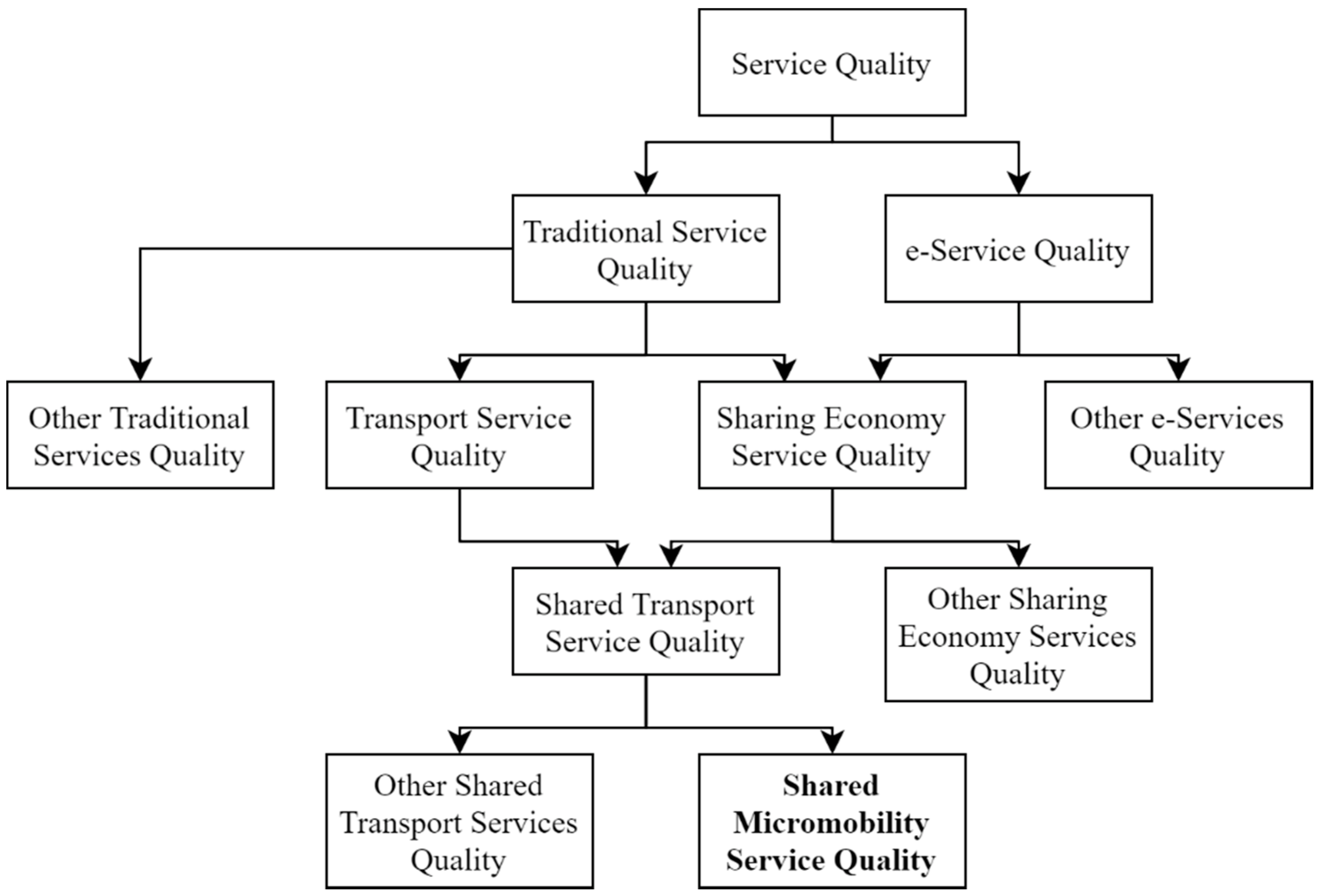
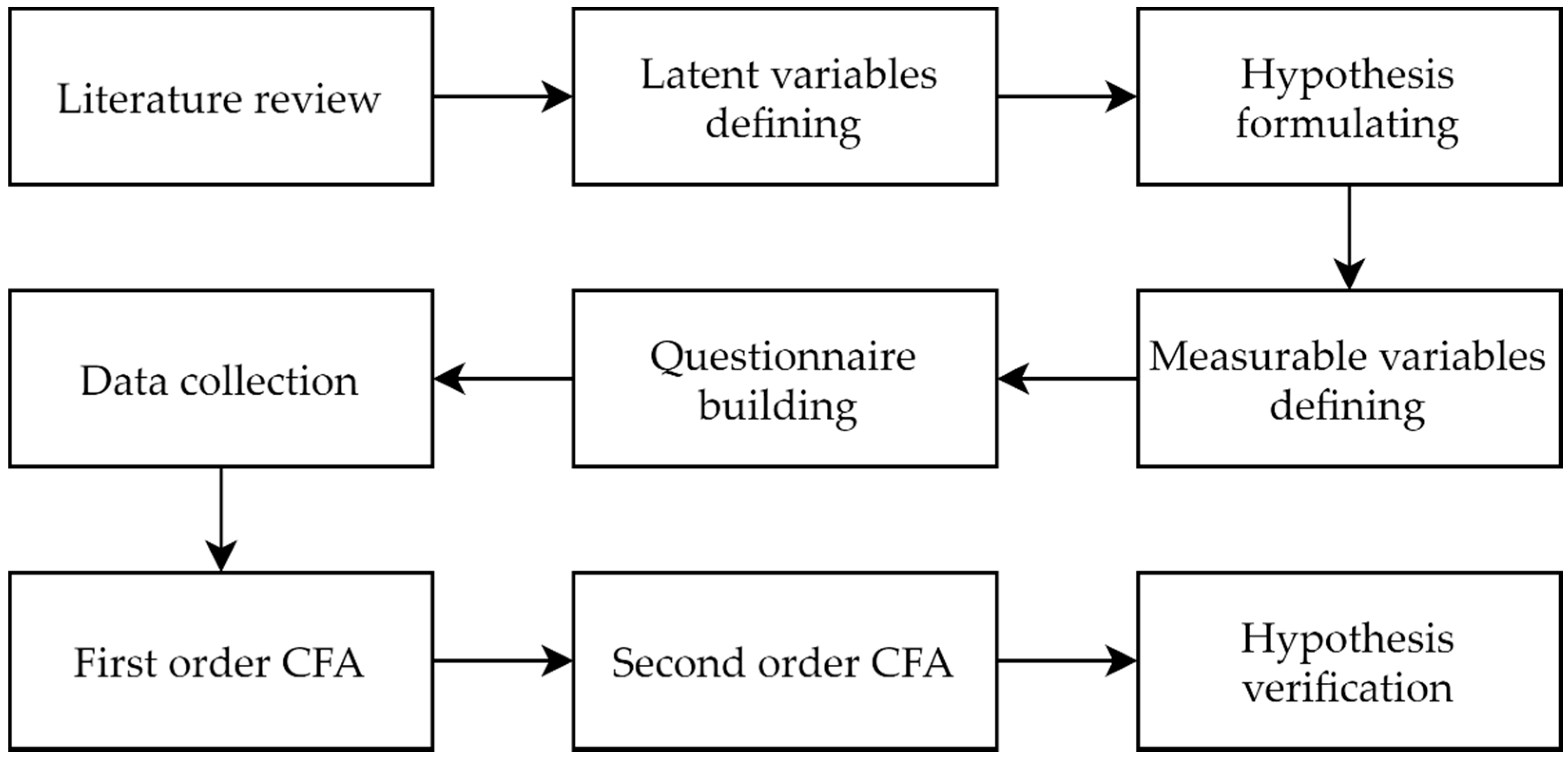
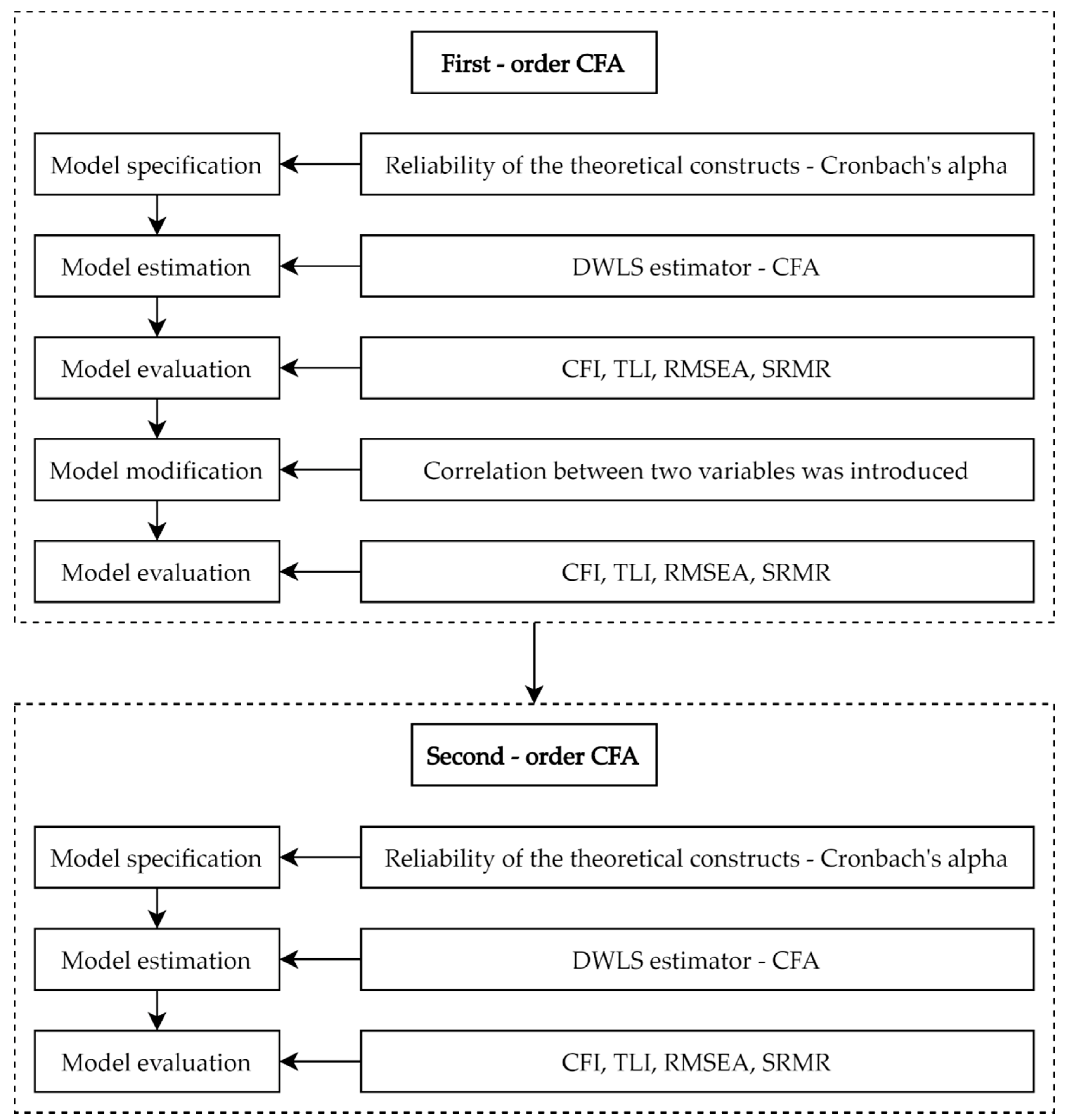
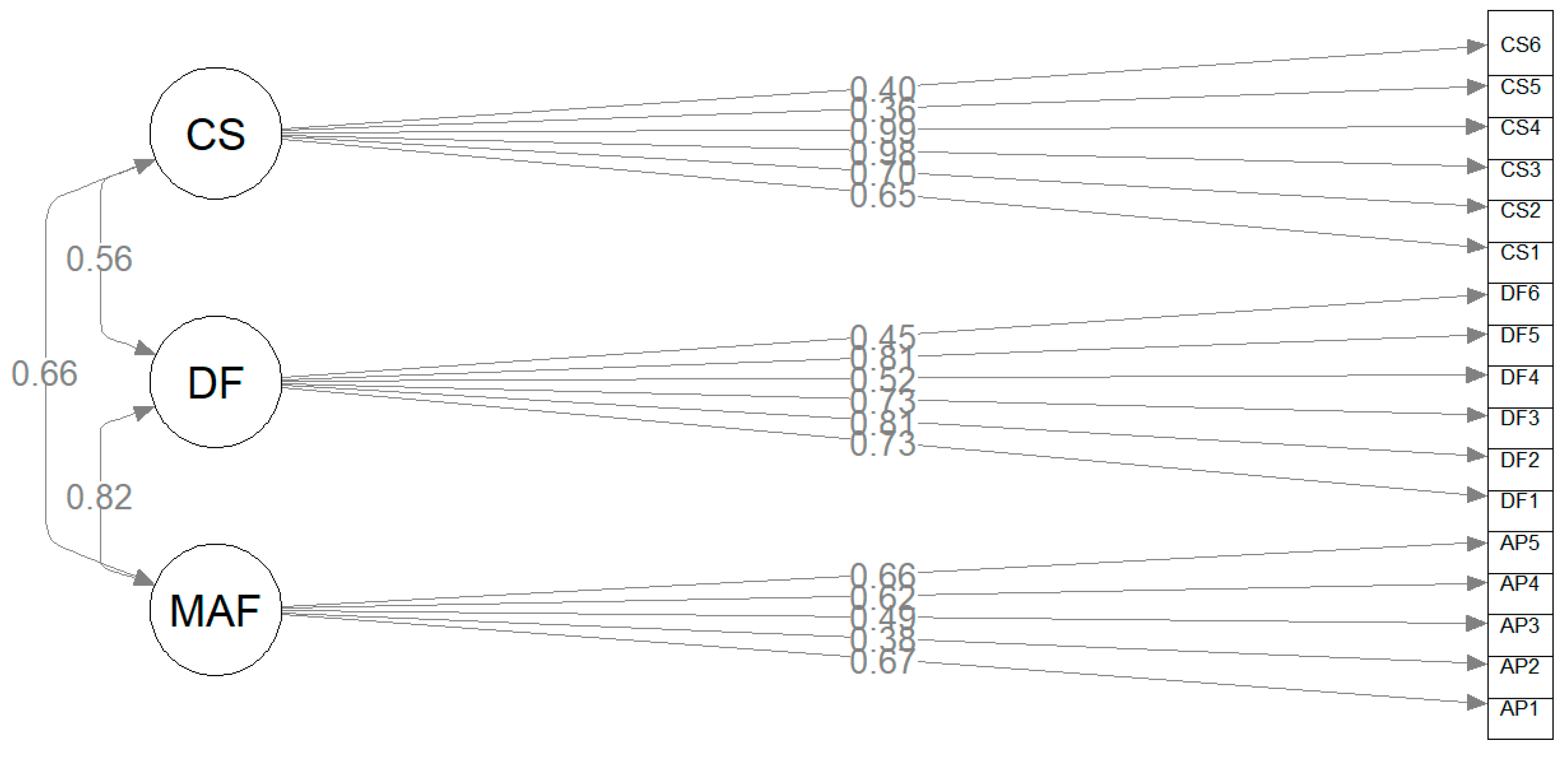

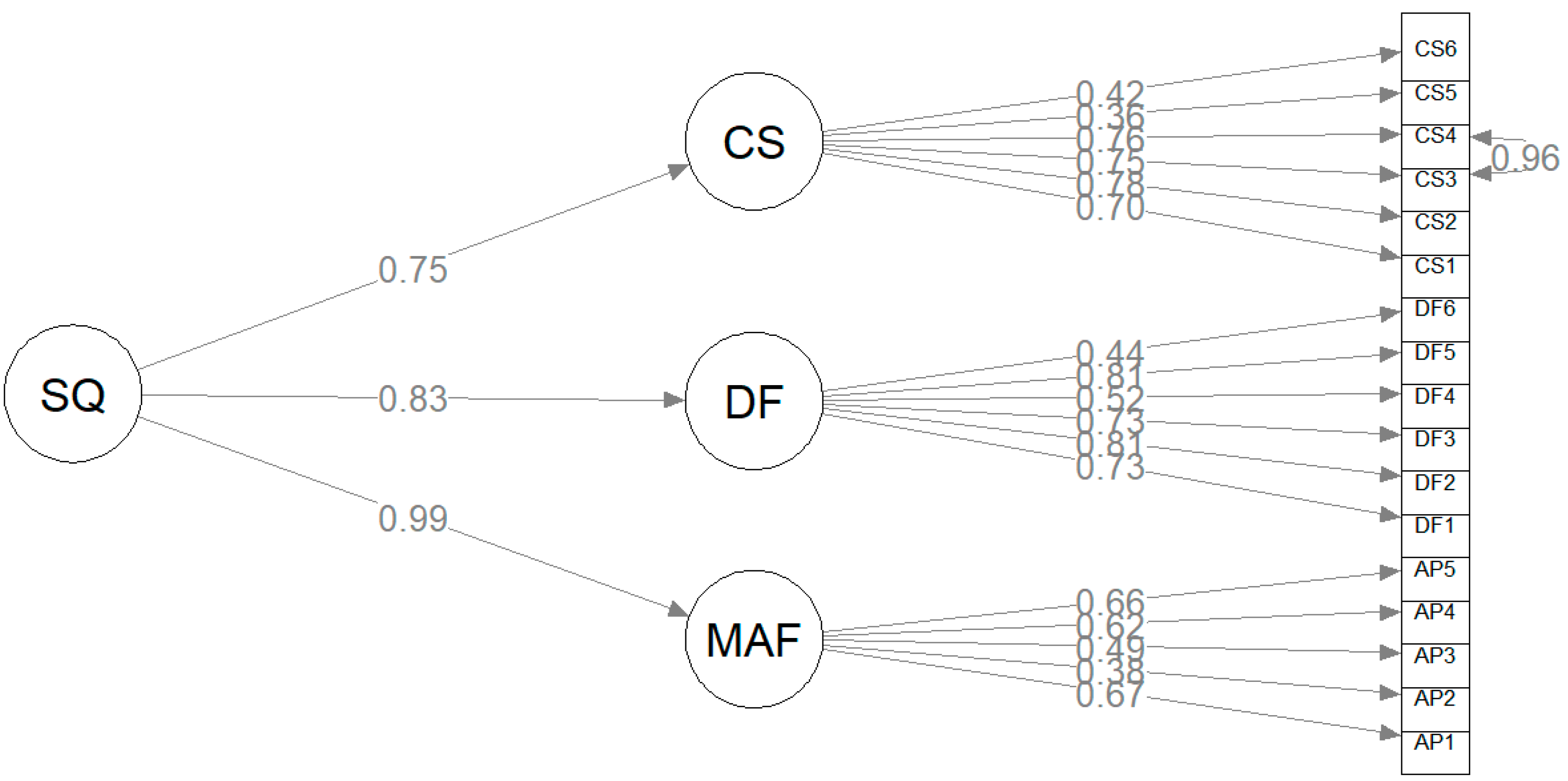
| Latent Variable | Measurement Variables (Observable) |
|---|---|
| Mobile application functions—MAF | Intuitive application interface—AP1 User can register an opinion about the used e-scooter—AP2 User can order/reserve the device in the application—AP3 Battery level compatible with the application—AP4 Fees charged in accordance with the tariff and time—AP5 |
| Device features—DF | Clean and aesthetic appearance—DF1 Ease and convenience of use—DF2 Adequate technical condition—DF3 Charge level of the e-scooter is sufficient for a minimum one hour ride—DF4 Security—DF5 Speed minimum 25 km per hour—DF6 |
| Customer service—CS | Easy access to technical service points—CS1 Access to a hotline—CS2 Helpful and patient staff—CS3 Staff with expert knowledge—CS4 Loyalty programmes (discounts)—CS5 Parking in designated zones—CS6 |
| Demographic Variable | Category | Quantity | Percent |
|---|---|---|---|
| Gender | Males | 303 | 52% |
| Females | 281 | 48% | |
| Age | Below 18 | 17 | 3% |
| 18–30 | 544 | 93% | |
| Above 30 | 23 | 4% | |
| Education | Primary | 6 | 1% |
| Secondary | 397 | 68% | |
| Tertiary | 181 | 31% |
Publisher’s Note: MDPI stays neutral with regard to jurisdictional claims in published maps and institutional affiliations. |
© 2022 by the authors. Licensee MDPI, Basel, Switzerland. This article is an open access article distributed under the terms and conditions of the Creative Commons Attribution (CC BY) license (https://creativecommons.org/licenses/by/4.0/).
Share and Cite
Hamerska, M.; Ziółko, M.; Stawiarski, P. A Sustainable Transport System—The MMQUAL Model of Shared Micromobility Service Quality Assessment. Sustainability 2022, 14, 4168. https://doi.org/10.3390/su14074168
Hamerska M, Ziółko M, Stawiarski P. A Sustainable Transport System—The MMQUAL Model of Shared Micromobility Service Quality Assessment. Sustainability. 2022; 14(7):4168. https://doi.org/10.3390/su14074168
Chicago/Turabian StyleHamerska, Monika, Monika Ziółko, and Patryk Stawiarski. 2022. "A Sustainable Transport System—The MMQUAL Model of Shared Micromobility Service Quality Assessment" Sustainability 14, no. 7: 4168. https://doi.org/10.3390/su14074168







